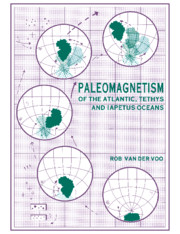Book contents
- Frontmatter
- Contents
- Preface and acknowledgements
- 1 Prologue
- 2 Paleopoles and paleomagnetic directions
- 3 Megaplates, microplates, blocks, terranes, accreted slivers, thrusts and olistostromes
- 4 Paleomagnetic information – what makes a paleopole valuable?
- 5 The major continents and Pangea
- 6 The opening of the Atlantic Ocean
- 7 The Tethys blocks
- 8 The terranes, blocks and adjacent continents of the Iapetus Ocean
- 9 Epilogue
- 10 Appendix
- References
- Index
8 - The terranes, blocks and adjacent continents of the Iapetus Ocean
Published online by Cambridge University Press: 24 November 2009
- Frontmatter
- Contents
- Preface and acknowledgements
- 1 Prologue
- 2 Paleopoles and paleomagnetic directions
- 3 Megaplates, microplates, blocks, terranes, accreted slivers, thrusts and olistostromes
- 4 Paleomagnetic information – what makes a paleopole valuable?
- 5 The major continents and Pangea
- 6 The opening of the Atlantic Ocean
- 7 The Tethys blocks
- 8 The terranes, blocks and adjacent continents of the Iapetus Ocean
- 9 Epilogue
- 10 Appendix
- References
- Index
Summary
Iapetus is the name given by Harland & Gayer (1972) to a Paleozoic ocean that was the precursor to the modern Atlantic Ocean. The name Proto-Atlantic has also been used. No coherent remnants of Iapetus Ocean floor exist, other than dismembered ophiolites emplaced upon continental crust by obduction. The name of Iapetus, as the father of Atlas, is appropriate in other ways as well: the birth and early history are very uncertain and obscured by latest Precambrian and early Paleozoic events, and even for the later stages in the life of this ocean, as for that of the mythological figure, few aspects are known with any certainty.
Before the seminal paper of J. Tuzo Wilson (1966), who queried whether – before the opening of the present-day Atlantic – another ocean existed that closed in late Paleozoic time, it was generally and often tacitly assumed that Pangea (see Chapter 5) was valid for all of pre-Mesozoic time. Wilson based his arguments to the contrary on faunal dissimilarities in terranes now juxtaposed; in the northern Appalachians, for instance, the American craton with its early Paleozoic ‘Pacific’ fauna contrasts sharply with the coastal strip of eastern New England and the Canadian Maritime Provinces which yielded the so-called Acado-Baltic (‘Atlantic’) fauna. Today, 25 years later, faunal arguments still play an important role in discussions about Paleozoic paleogeography, as do latitudinal indications provided by sedimentary facies (glacial relicts, elastics versus carbonates, coal, evaporites, etc.).
- Type
- Chapter
- Information
- Paleomagnetism of the Atlantic, Tethys and Iapetus Oceans , pp. 229 - 266Publisher: Cambridge University PressPrint publication year: 1993
- 1
- Cited by



